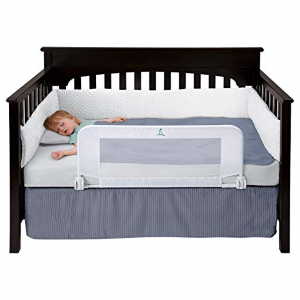Transitioning from Crib to a Toddler Bed
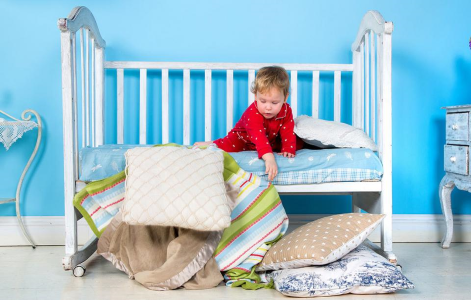
It seems like just yesterday you were cradling your tiny newborn in your arms, rocking her to sleep, and wondering when (if ever!) she would sleep through the entire night. Now that your little baby has grown into a full-fledged toddler, you may be thinking about the NEXT exciting sleep phase in her young life: transitioning from the crib to a toddler bed.
The graduation from crib to a toddler bed is exciting and scary all at once. After all, will your kid ever sleep again once she discovers the newfound freedom of a bed without rails? Will you?? You may have visions of her roaming about the house at night. Eating unlimited amounts of old Halloween candy.
Don’t worry — everything you’re feeling is TOTALLY normal and we are right there with you. More importantly, we want you to know that transitioning to a toddler bed is a milestone that’s full of positives. Not only will your child gain new coping skills, she will develop a greater sense of independence.
Crib to Toddler Bed: Timing
Some parents make the switch out of necessity to make space for a baby on the way, while others (like me, Marissa) do it as a safety measure. Once your child learns to climb out of the crib… AHH!
Not so fast, warns pediatric sleep coach and founder of Tender Transitions, Leann Latus, (PCD)DONA, CLC. She says taking your child out of the crib when they start climbing out often results in a premature transition.
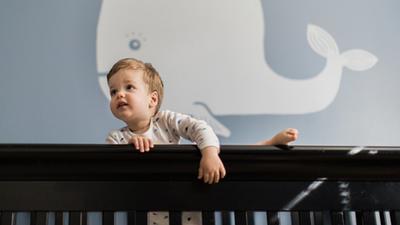
Watching your toddler trying to climb out of the crib can be scary and seems unsafe, she said, but “sometimes it’s just a quick phase they go through, and if parents don’t give it much notice, the child may move on and go back to being okay in the crib.”
Outside of crib jumping, when should you consider moving your child from her crib to a toddler bed?
Is your kiddo mature enough to handle the responsibility of such freedom? Kids feel safe in their cribs — it’s familiar, cozy and snug. When they move to a toddler bed, they no longer feel “protected” by the space and safe confines of their crib slats. What’s more, they have a better view of their big room and all the fun stuff that’s now within arm’s reach. Resisting the temptation to play with all the toys – or worse, leaving the bedroom – is overwhelming.
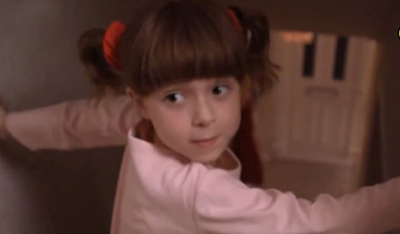
Kim West, a licensed clinical social worker also known as “The Sleep Lady,” recommends to wait until the age of three (two and a half years old being the earliest) to transition a child from a crib to a toddler bed. Right around that time, “children have a little more impulse control and are simply better able to overcome the urge to get out of bed,” she said in her article in U.S. News & World Report. “If you move your child to a big bed too early, you may experience more tears, tantrums and sleep disruptions.”
This falls in line with recent research published in the journal of Sleep Medicine, which states that when parents wait to move their kids into a big kid bed until they’re 3 years old, everyone — parents and toddlers alike — gets better sleep.
All in all, 3-year-old kiddos tend to be less resistant at bedtime (tell this to my kids… ha!), have fewer night awakenings and sleep for longer periods of time. Not to mention, a 3-year-old is more likely to be able to understand the “staying in bed at night” rules. That’s why most sleep experts agree: don’t rush it. Some kids seem ready at 18 months while others not until age 4. But if your child doesn’t show any interest in getting out of the crib, it’s okay to keep her there until she is ready to make the transition. Bottom line: there is no hurry.
When NOT to Transition to a Big Kid Bed
Are you moving to a new house? Is your new baby due any day now? Or maybe your little one is starting preschool, potty training or weaning? Experts recommend not to initiate the move to a toddler bed at the same time as other life-changing events. Otherwise, you may find yourself having to transfer your child back to the crib.
A Tale of Two Different Crib-to Bed-Transitions
Charlene and Melissa, two members of our team, both transitioned (or, in Charlene’s case, tried to transition) their older kids to beds because they were expecting baby #2. Here’s how it went for them…
Charlene’s Experience
I transferred my son into a toddler bed when I was expecting baby #2. He was just over 2-years-old at the time. The transition was seamless at first, but after two months of uninterrupted sleep, my son started getting out of bed every two minutes. He would do things like wander around the apartment or he would take all of his toys out of their bins and dump them in his bed — including his toy stroller and vacuum, which would take up all the space in the bed and wake him up (go figure!).
After one week of multiple wakings, I decided to move him back to his crib, where he stayed until he was about 4-years-old. It worked out ok, but the process was disruptive and confusing for everyone.
Melissa’s Experience
I transitioned Jackson to a big bed when he was three-and-a-half years old. He was very content in his crib and never tried to get out when it was time for nap or bedtime. At 3.5, we felt that he was mature enough, and he was looking a little scrunched in his small crib. We waited about 6 months after his baby sister was born so that he wasn’t hit with two major life changes at once. All in all, it went really well! The first night or two were tough, but once he got the hang of it, he slept just fine in his new bed.
Furnishings
If you’ve decided that now is the time to move your toddler to a big kid bed, you’ll need to take a few steps to make the transition as smooth as possible.
First, you’ll need to choose a bed. Here are the main options:
- Mattress on the floor: A twin mattress placed directly on the ground works very well. This is more of a Montessori-style approach, and some parents find this works really well for their kids.
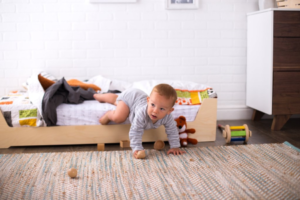
- Convertible crib: Many cribs convert to a toddler bed, which is also known as a “convertible crib”. These usually come with a conversion kit to remove and replace the slats on one side with a shorter rail. Not only do convertible cribs last longer (more bang for your buck), they’re already a familiar environment for those kids that have more difficulty with change.
- A toddler bed: This is basically a mini-version of a twin bed that you can buy at IKEA, Target, Pottery Barn Kids, Wayfair, etc. Check Craigslist, Nextdoor and all your favorite second-hand sources as well. With all the fun options out there, you have a great opportunity to really get your child excited about her bed (a great first step to a smooth transition, but more on that later). Bonus: toddler beds use a crib mattress and crib bedding, so the only other thing you’ll have to buy is a pillow and a comforter. A toddler bed works well if you have younger children you can pass it down to. The downside is that they will outgrow the toddler bed well before a regular twin bed, for example, then you’ll have to do the furniture shuffle all over again.
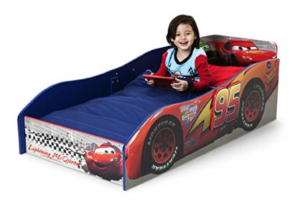
- A twin bed with guard rails: This can last until their teenage years. Meg’s girls (9 and 6) still happily sleep in their twin beds and will for years to come. Beds from kid’s stores, like Pottery Barn Kids, tend to be lower to the ground. The regular twin is also big enough for mom or dad to climb in to read or snuggle when needed (the toddler bed, not so much).
Whatever bed you choose, you’ll also need a lot of encouragement. If you show your kids that you’re nervous or flustered, they will be too. As they go through this change, they’ll look up to you for comfort and reassurance that everything will be a-okay, so try to remain calm and steady — even if you’re faking it!
Bedding
If you wind up with a transitional crib or a toddler bed, you’ll be able to use the same crib sheets and mattress (insert praise hands here). Target has some adorable toddler bed bedding, as does Amazon, and more.
If your child hasn’t yet used a pillow (what – a pillow??), this might be a good time to get one. Toddler pillows can be a little hard to find, but they are usually 13″ x 18″ or so and are thinner for their smaller bodies/necks (regular adult pillows are waaaay too big for their necks). These toddler pillows by Little Sleepy Head are great, and just the right size for the preschool crowd. All of that said, many kids don’t take to pillows until later (5+) — probably because they’ve come this far without one (safe sleep guidelines and all) and they aren’t used to them.

Preparation
- Talk about it. Talking about friends, older siblings or cousins who sleep in big kid beds can help your little one get excited about sleeping in a big kid bed, too.
- Read about it. You can help prepare your toddler by reading books about moving from a crib to a big kid bed. We love Big Enough for a Bed and Big Kid Bed, but there are tons of fun ones out there!
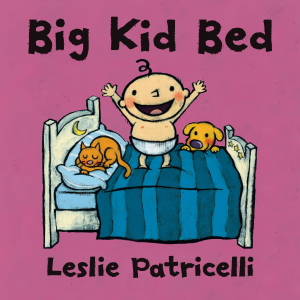
- Involve your tot in the process. In other words, take her shopping and allow her to play an active role in this transition by allowing her to choose her bed (if possible) and new bedding. This will not only give her a sense that she is safe and in control, but also get her excited to physically go to bed.
- Keep things as familiar as possible. Set the new bed up where the crib was. Keep comfort items as they were before: if your child sleeps with a blankie, teddy bear, lovey, etc., make sure these items are still there.
- If you’re using a twin bed, put the mattress directly on the floor at first. The proximity to the floor will be safer as she gets used to the new bed; plus, it will feel cozier.
- Have a big kid bed party. The night before the big move, put the new bed in the room, right next to the crib. Have some of your tot’s favorite loveys sleep in it. You can do the bedtime routine with your little one as usual, but then act out the bedtime routine with the stuffed animals. This will help them get a preview of the new routine and understand what’s going on.
- The night of, start the bedtime routine a bit earlier than usual. Be vocal about what’s about to happen — let them know they are going to sleep in their new bed. What you do next will depend on your kid. But in general, try to make it clear from the start that at nighttime, they need to stay in bed.
- Be patient. The first week, don’t expect things to go perfectly. Your toddler will likely get out of bed and test out the boundaries of this new setup…repeatedly. Throughout this transition, set boundaries and rules, but remain calm and empathic. More on this a little later…
What Happens to The Nap and Bedtime Routine?
A new bed doesn’t necessarily mean a new routine. In fact, if you want a smooth transition, it’s best to keep the structure of the nap and bedtime routine as intact as possible. For instance, if you’re used to giving your little one a bath and reading a book before bed, then continue to do just that.
Many times, the logistics get easier. For example, you can now read a book with them in bed instead of in a rocking chair. This will help your tot get used to the bed, as well as give you a sweet, cozy time together to snuggle before it’s time to go to sleep.
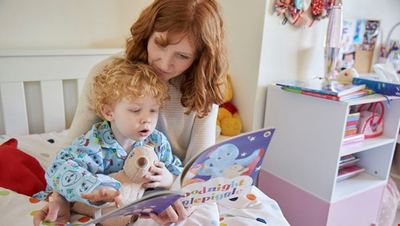
In the midst of this transition, try to remember that regression is perfectly normal. At some point or another, your toddler may want her old crib back, even if she has been super excited about moving to a big kid bed. This is normal — some setbacks are part of the process.
Staying Put During Naptime: this transition sometimes occurs around the time that kids start dropping their daily nap. If you find that nap time is becoming harder once your little one is in a big kid bed, don’t feel discouraged; and don’t drop the nap entirely and automatically.
Downtime during the day is still important for children to recharge. So try to enforce a “quiet time” nap, where your child has to stay in bed but can read books (or some other quiet time activity). Whether she ends up falling asleep or not, it’s a good opportunity to give her a break and the energy she needs to make it until bedtime.
How Do You Keep Your LO in Bed?
There’s nothing more terrifying than waking up at 2 a.m. to a small child standing two inches from your face. Believe me — it’s the stuff of horror films, and it happens to the best of us.
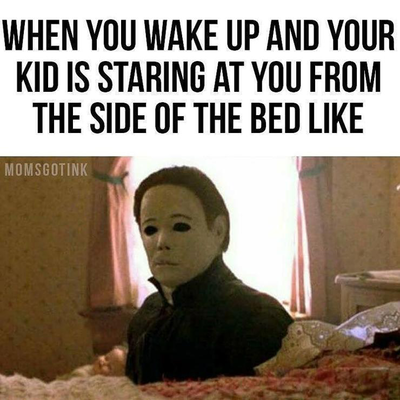
Your little one now has the opportunity to LEAVE her bed in the middle of the night, and chances are, she will take it. She may do things like roam the house, play or wake you up repeatedly. Eesh. This is one of the most challenging parts of all of this milestone. But don’t worry, parents — it’s gonna be okay. There are several measures you can take to teach your child to stay in her bed at night.
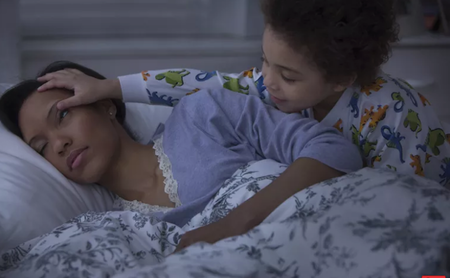
Last Call! For starters, enforce a last call for water, bathroom trips and other requests before sleep. Kids are amazingly skilled at stalling bedtime and at finding reasons to come out of bed (several times) once you’ve shut the door. So aside from making sure their needs (whether real or just stall tactics) are met BEFORE leaving the room, you’ll want to teach your toddler that once you shut off the light, it’s officially time to stay put — nighttime is for sleeping.
Sleep Training Clocks
According to pediatric sleep coach, Leann Latus, sleep clocks can help keep your children in bed throughout the night, along with “using a small incentive or reward right away in the morning if your child has remained in their bed all night.” Early rising can also be a big problem (am I right!?!???). Coming in at 5am on a Saturday to tell you that a rattlesnake can eat a cobra, for example. In fact, you’re going to learn more fun facts about animals during the night than you ever wanted to know!
An “Ok to Wake” clock, for example, uses color to let your little ones know when they are allowed to come out of their beds.
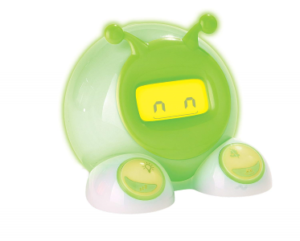
This is particularly helpful for early risers and worked really well for my oldest daughter, who truly struggled with staying in her bed all night and until a reasonable hour in the morning. Melissa had a similar experience, saying it only took her son a few days before he understood that he needed to stay in bed until his clock turned green.
She’s Out. Now What?
If your child does get out of bed, place her back in. Each time you do (it may be a few times a night), keep it short and boring (we know you’re not boring, but let your kiddo believe you are). Don’t get angry (HIDE your anger, rather). If she gets any reaction from you whatsoever — if she sees that getting out of bed makes you laugh or makes you angry — it will reinforce this behavior, and she’ll be more likely to do it over and over and over again. The key with this approach is that you must stay consistent. If at any point you deviate in any way — i.e. allowing your child to sleep in your bed “just this once” or give her any attention while walking her back — this method will not work. Consistency is key.
An extreme example is this famous episode of Supernanny where she put the child back in her bed 47 times. No exaggeration! Talk about a battle of wills!! Granted, this is an extreme example where they are trying to correct some very bad habits that had formed over the years, but the point is the same. Stay calm. Be consistent. Expect them to test you — and don’t be angry when they do.
Some parents have a hard time with this method, which is completely understandable. It’s not fun — who wants to get out of bed a jillion times a night to walk their kiddo back to bed?! But if done right, you should only have to do it for a couple of nights (maybe not even that long), before your child gets the message that coming to see you at night just isn’t worth it. Don’t laugh, but I learn a lot from Supernanny! She’s my spirit animal.
If this approach is not working and your little one is continuing to come out of bed repeatedly at night, you may try a baby gate, such as the Munchkin Easy Close Metal Baby Gate. This way, your child can’t leave her room, but you can still keep her door open to ease her fears of being alone at night.
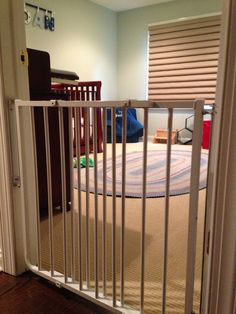
There are other toddler sleep training methods as well, such as the “Pick Up/Put Down” Method, the “Longer and Longer” Method (both discussed by Dr. Harvey Karp here), and the “Bedtime Pass” in which your child is allowed only ONE pass to come out of bed at night for an acceptable reason (i.e. a drink of water, a trip to the bathroom, etc.). Once your child has used the pass, it is given back to the parents for the remainder of the night and cannot be used again until the next evening.
Pediatric sleep coach, Leann Latus, also suggests trying “check-backs”. “Tell your child that as long as they lie quietly IN THEIR BED, you will check back on them in 3 or 5 minutes,” she said. “The check-back alone can be a nice reward or payoff for the child because they love to see you again. Make sure your check-back is brief, calm, and positive and affirms for your child that they are doing a great job staying in their bed.”
Praise! If your little one likes to be praised for her hard work (aka most toddlers), you may want to start a Nighttime Sticker Chart. When your LO goes to bed nicely and stays in her bed all night long, she gets to place a sticker on her chart when she wakes up in the morning. At the end of the week if she’s gotten all her stickers consecutively, she gets to pick out a prize (this is where dollar store toys come in super handy! You can create a “prize bag” with lots of little trinkets and toys).
Lying down with your kids: yes or no? According to Leann Latus, “during this transition many children will start to ask you to stay or lie down with them until they fall asleep. While some children can do well with this, it can often turn into more night wakings and the notion that they need you to fall asleep. So always try to leave their bedroom before they fall asleep.”
Easier said than done – ha!
Safety
Since your child will have access to the whole house, you might want to take extra safety precautions. First, if your little one rolls around a lot at night and you’re worried she may go crashing to the floor, surround her bed with pillows or soft rugs.
You can also get guard rails to keep your kiddo from falling out of bed, such as the well-reviewed Hiccapop Convertible Crib to Toddler Bed Guard Rail.
This is a great double guard rail which is useful when one side of your child’s bed isn’t pushed up against a wall. Bonus — inflatable bed rail bumpers are not not only great for home, but they’re also perfect for travel! Just deflate, pack, and inflate once you arrive at your destination.
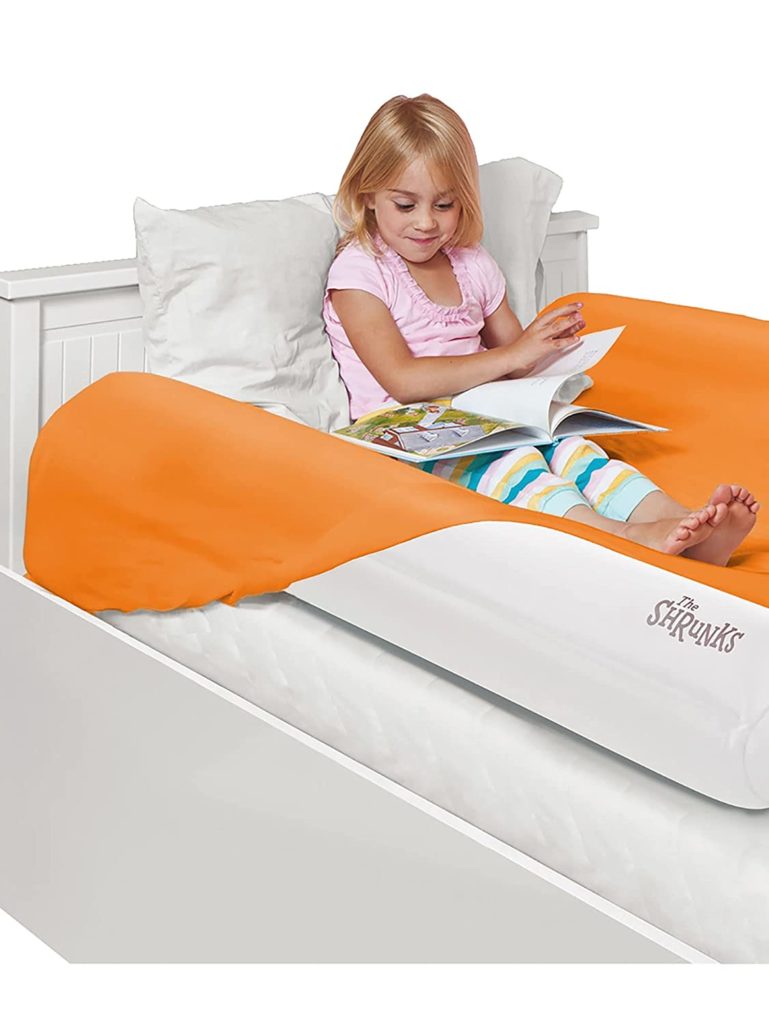
Aside from this, make sure your house is sufficiently baby-proofed!
- Is all your child’s furniture adhered to the wall — especially anything that could tip over onto your child (i.e. dressers, bookshelves, etc.)?
- Are the windows locked?
- Is there a baby gate at the top of the stairs that you can close every night?
- Do you have an alarm on any doors your child might try to sneak out from?
- Are the cabinets with sharp objects and hazardous chemicals securely locked?
Taking care of these little things will help you rest a little easier.
See Also: Babyproofing Your Home
Bottom line: Transitioning your kiddo from a crib to a toddler bed is a big deal — for your child and for you. This developmental milestone really means your little one isn’t so little anymore (tear, tear…we totally get it!!). While of course this change can invoke feelings of stress and anxiety for the whole household, please know that the tough moments will pass, and your child will get the hang of sleeping in a big bed.
Good luck, parents! Now go catch some zzz’s!
